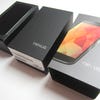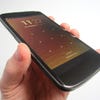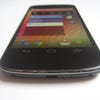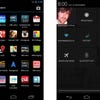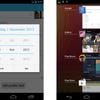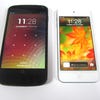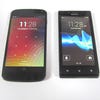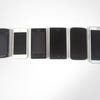Google Nexus 4 review
Nexus Phwoar? Digital Foundry reviews the quad-core Android which costs half as much as the iPhone 5.
Google's Nexus program may be the closest the company has come to challenging Apple's iPhone with a focused product, but thus far it has proven to be curiously muted. The Nexus One cut out the mobile networks and was sold online directly to the general public - a strategy which resulted in lacklustre sales. The subsequent Nexus S and Galaxy Nexus fared better, but still didn't generate the kind of near-religious fervour from buyers that Apple's phones tend to do.
For the fourth Nexus phone, Google has enlisted the assistance of South Korean manufacturer LG, and once again returns to the concept of cutting out the middleman and retailing the phone directly to consumers via its online Google Play store. The recent launch was a much-publicised sell-out, with the entire launch shipment being snapped up within half an hour - an outcome which arguably has more to do with the Nexus 4's astonishingly low SIM-free price (£240 for the 8GB model, £270 for the 16GB) than the quality and allure of the handset itself.
Disgruntled would-be buyers aside, the Nexus 4 is - in terms of pure column-inches, at least - Google's most successful Nexus yet. On paper, it packs some impressive features, including a quad-core processor, 4.7-inch IPS screen, wireless charging, NFC support and Gorilla Glass 2 protection on both the front and back of the device. But is it actually any good?
Design: a glass act
Since the starkly minimalist tone of the Samsung-made Nexus S, the Nexus lineage has shared a common stylistic theme; no buttons on the face of the device. Despite the fact that the torch has passed from Samsung to LG, that ethos hasn't shifted. From the front, the Nexus 4 is almost identical to its predecessor, the Galaxy Nexus. It's only upon closer inspection that the differences come to light.
For starters, there's that 4.7-inch screen. It's a touch larger than the 4.65-inch display of the Galaxy Nexus, and the switch from Super AMOLED to IPS tech brings both benefits and drawbacks. AMOLED screens showcase bold hues and deep blacks, while IPS panels tend to represent a more faithful reproduction of colour, but are less convincing when it comes to contrast. Placed side-by-side with the Galaxy Nexus, the Nexus 4's screen does seem a little washed-out, but it's sharper and somehow warmer - especially when viewing photos and videos. Viewing angles are entirely rock-solid, refusing to budge no matter which angle you gaze at the screen from.
The screen itself is clad in Gorilla Glass 2, which makes it extremely resistant to marks and scratches. Rather than being an entirely flat panel, the glass curves off towards the sides. It's a subtle yet pleasing effect which means your fingertips slide off the screen, rather than hitting a sharp edge. Turning the device over reveals another sheet of Gorilla Glass 2, this time sporting LG's much-hyped "crystal reflection process" - an eye-catching shimmering effect made up of a multitude of sequin-like dots. Initially, it looks as if the back of the phone is just plain black, but once it catches the light the visual effect is quite striking.
Between the front and back sections of glass there's a two-tone section of plastic bodywork. A combination of rubberised black and shiny faux-chrome, this element of the design is the only area that feels slightly cheap, but it does at least offer some grip. As was the case with the iPhone 4 - which also boasted front and back panes of glass - the Nexus 4 is sometimes difficult to grip. The back of the device - an area which on many phones offers a textured surface for increased purchase - is totally slick, which means you may want to invest in some kind of case, especially when you consider that one accidental droppage is all that it will take to shatter those attractive pieces of glass.
Packed away inside that sleek, glass-covered exterior is a Snapdragon S4 Pro chipset, comprised of a 1.5 GHz quad-core Krait CPU and an Adreno 320 graphics processor. A voluminous 2GB of RAM is included to keep things moving as smoothly as possible, and the resultant leap in performance over the Galaxy Nexus is instantly noticeable. UI speed is very fast, and moving between applications is near-instantaneous. No matter what kind of task we threw at it, the Nexus 4 didn't stutter or pause once.
Software: Jelly Bean upgraded
Previous Nexus devices have usually been accompanied by a new and exciting software release; the Nexus S brought us Gingerbread (Android 2.3), the Galaxy Nexus had Ice Cream Sandwich (Android 4.0) and the Nexus 7 tablet marked the debut of Jelly Bean (Android 4.1). The Nexus 4 offers an incremental update of Jelly Bean rather than an entirely new release, and that does take a little of the lustre away from the device; the Galaxy Nexus has also recently received an over-the-air 4.2 update, which reduces the unique appeal of the Nexus 4 even further.
Still, 4.2 does offer some welcome enhancements over 4.1. The most obvious is the quick settings menu, which is accessed via the pull-down notification pane. From here you can adjust various elements of the phone's functionality, including screen brightness, Wi-Fi, Bluetooth and Airplane Mode. It's an idea which several other Android manufacturers have already introduced in their own custom UI skins, and in some ways is less intuitive here - why not have a row of icons in the notification area to control these elements, therefore removing the need for the second tap of the screen to open the settings menu?
"The Nexus 4 holds up well in standard benchmarks, with GPU scores in particular moving well beyond the Tegra 3 chipset."
| Samsung Galaxy Nexus (Android 4.1) | HTC One X | Razr I | Nexus 4 | |
|---|---|---|---|---|
| Quadrant Standard | 2078 | 4870 | 3205 | 4906 |
| AnTuTu Benchmark | 4724 | 11065 | 8420 | 10580 |
| Vellamo | 1199 | 1661 | 1521 | 1314 |
| GLBenchmark 2.5.1 Egypt HD On-Screen/Device Native Res | 8.3FPS | 21.7FPS | 13.8FPS | 39FPS |
| GLBenchmark 2.5.1 Egypt HD Off-Screen/1080p | 5.4FPS | 14FPS | 7.8FPS | 31FPS |
Another new addition is lock screen widgets. Active widgets have been part of Android for years, and the notion of adding them to your lock screen is reasonably established, too - at least among app developers, anyway. It's handled particularly well in Android 4.2, though. Swiping to the right opens up the camera, while swiping in the opposite direction gives you access to your widgets. You can view your email inbox, check your MMS messages and study calendar appointments, all without having to unlock your handset. This feature should be used with caution, however - if you like to keep your phone locked-down with either a pin code or pattern-based security system, you should be aware that people can gain a partial view of things you may wish to remain secret.
Fans of trace-to-type keyboard replacement Swype will be pleased that Google has finally incorporated something similar into the core OS. Android 4.2's version has an additional bonus: as you're tracing the line around the keys, a pop-up window shows the word you're currently spelling, in real time. This feature makes your typing more accurate, but we noticed that for sheer speed, Swype still wins. Fast typing (or tracing, if you're going to be picky) on Google's equivalent seems to result in more mistakes, although that could change over time as the company improves the underlying prediction software.
However, the biggest attraction to most hardcore Android fans will be the 'pure' nature of the OS itself; as this is Google's own 'first party' phone, it is mercifully free of the manufacturer-produced UI skins and bloatware which blight other Android devices. What you're getting here is the barebones version of Google's mobile OS, which may sound like a negative but is in fact a massive positive; the 'stock' Android software is cleaner, smoother and faster, and although it lacks embellishments such as Samsung's 'intelligent screen' which stays awake when you're looking at it and Motorola's SmartActions, similar functionality can easily be obtained via downloadable applications such as Tasker and Screebl. If you're after a blank canvas on which to being your Android experience, this is it.
"The Nexus products offers us a 'pure' untampered with Android OS experience and while 4.2 isn't much removed from its predecessor, it features a small range of nice additions."
Even so, it's not entirely perfect. All new software offers the potential risk of bugs, and Android 4.2's most notable cock-up is particularly embarrassing. When adding a date to a contact in your phone book, it's currently impossible to assign the month of December. Google is working on a fix which should be pushed to handsets in the very near future, but it's an unfortunate omission which has no doubt caused mirth amongst Apple devotees.
As we alluded to earlier, the Nexus 4 is available in two flavours: 8GB and 16GB. Neither version has any form of expandable storage, so if you do pick the smaller (and cheaper) edition, you need to be aware that things are going to be very tight in terms of space. Thankfully, with UK access to Google Music rolling out alongside the phone (it's been US-only so far), the problem is less dramatic than you might at first assume. Google Music allows you to store 20,000 of your own songs in the cloud, and even features a music-matching service which looks at your tracks and grants access to high-quality versions in Google's own library, to save you the onerous task of having to upload your entire music collection. Picasa - Google's photo and video service - also allows you to store other media which might otherwise clog up your internal memory. Naturally, all cloud services require a robust data connection and eat up plenty of megabytes, so you may wish to check the monthly data allowance and fair usage terms your current mobile provider has in place before taking Google up on its offer of free online storage.
Because of the glass front and back, LG has been forced to opt for an entirely sealed case design, which naturally precludes the addition of a removable battery. This is going to be a blow to those who favour carrying a spare power cell for long journeys, but we noticed some pretty robust performance from the phone's 2100 mAh battery. To boast that an Android phone is capable of getting through an entire day shows how much mobile phones have changed from the era when your dependable Nokia could last an entire week on a single charge, but the inescapable fact is that while battery technology and capacity have improved, the size of the power cells has shrunk - yet they are expected to provide juice to ever more demanding technology.
"The 8GB Nexus 4 is very cheap, but there's no expandable storage so that sorry state of affairs needs to be factored into the purchasing decision."

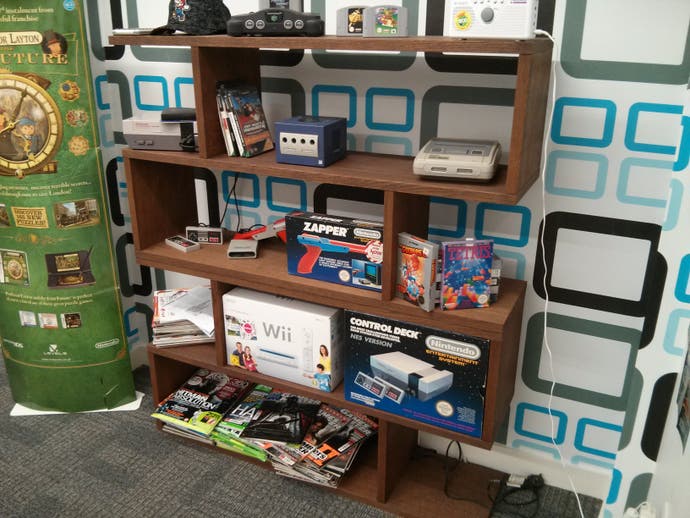


With the Galaxy Nexus, we would usually find that the phone was gasping for air before we'd even gotten halfway through the day. The spectacle of Samsung's handset lasting from morning until night was a rare one, if it ever happened at all. Adopting an identical usage pattern with the Nexus 4 yields more positive results - charging fully in the morning usually means you'll get through until bedtime without having to moderate your internet browsing, music playback or bursts of interactive entertainment. As ever, it's that screen which sucks up the most power, so keeping it dim and on a fast time-out helps prolong stamina. Although the Nexus 4 supports wireless charging, we were unable to test this element due to the fact that Google has yet to release the official charging pad.
When it comes to gaming, the Nexus 4 provides a solid platform - at least on paper. The Snapdragon S4 Pro is adept enough to keep up with the latest 3D titles, provided you can actually get them to load, that is. Games like Dark Meadow and Shadowgun: DeadZone - two titles we're rather keen on using when benchmarking Android devices - refused to load. It's possible that this is due to incompatibilities with Android 4.2 rather than underlying issues with the hardware, but it's disappointing all the same.
Thankfully, we did manage to get some other 3D efforts functioning on the Nexus 4, and came away impressed with the phone's power. Our biggest concern - aside from the fact that quite a few titles wouldn't play - was the intense level of heat generated by the device after just a short portion of gameplay. This is a common feature of many super-thin quad-core mobile phones - the heat produced by those chips simply has nowhere to go, thanks to the svelte nature of modern mobile case designs. It just seems especially noticeable here, as the Nexus 4's glass back conducts the warmth more effectively than a plain plastic frame would.
"The capable Nexus 4 GPU suggests that this should be an excellent games machine, but we found that many titles are currently incompatible with the handset."
Nexus 4: the Digital Foundry verdict
For the price that Google is asking for this handset, it's an absolute steal. The raw power contained within the Nexus 4 is superb, although it should be noted that it doesn't really improve on what already exists out there; other phones already boast similarly powerful processors and massive screens - the big difference here is that SIM-free they retail for approximately twice the price of the Nexus 4.
Just as it did with the Nexus 7 tablet, Google has priced its new phone as low as possible to ensure gargantuan amounts of interest, and it has worked - possibly a little too well in fact, given the swift sell-out and large volumes of annoyed shoppers posting on Android message boards the world over. The Nexus 7 has taken a considerable bite out of the tablet market - a sector where Android has traditionally struggled in the face of Apple's dominant iPad - but mobile phones are different. The Nexus 4 is competing with a wide range of very successful Android-powered rivals, and on a monthly contract, it's unlikely to offer the same compelling value for money as it does in its SIM-free and unlocked form.
"If you desire the purest mobile form of Android possible and value speedy software updates, the Nexus 4 is unquestionably the phone you should be getting."
If you desire the purest mobile form of Android possible and value speedy software updates, the Nexus 4 is unquestionably the phone you should be getting - assuming you haven't already resorted to paying extortionate prices on re-seller sites like eBay, of course. For less discerning buyers the decision is a little less straightforward; placed side-by-side, there's a good chance that to the layperson, the Samsung Galaxy S3 will look like the more attractive choice.
Ultimately, whether or not you should be laying down your cash for this phone depends largely on where you are with your current handset; Galaxy Nexus owners accustomed to purchasing a SIM-free upgrade every twelve months need mull over this no further - LG's phone is almost half the price that the Galaxy Nexus initially retailed for at the end of 2011. However, if you're already aboard the quad-core Android express then the Nexus 4 is unlikely to offer any massive improvements over your current phone - aside from a slightly newer version of the OS and wireless charging. Taken on its own merits though, it's a fearsome handset and comes with a truly astonishing price tag, and should ensure that Google takes another step closer to its dream of becoming a major player in the Android hardware market - rather than just being the company that cooks up the software.


